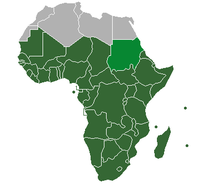
Photo from wikipedia
Background and Objectives: Injera (a fermented pancake-like product) is a traditional food in Ethiopia but is traditionally made from tef (Eragrostis tef). But sorghum also a traditional Ethiopian crop can… Click to show full abstract
Background and Objectives: Injera (a fermented pancake-like product) is a traditional food in Ethiopia but is traditionally made from tef (Eragrostis tef). But sorghum also a traditional Ethiopian crop can be used although considered having a lower quality. A 139 sorghum (Sorghum bicolor) cultivars and their corresponding injera were tested for a range of chemical tests, namely total starch, amylose, and tannin contents, plus a newly developed image analysis program to provide objective measures of the injera. Findings: The results showed several sorghums were superior to tef in making injera, based on the chemical, image, and/or sensory analysis. Tannin content was highly positively correlated with color and negatively with taste, while high starch content was more related to softness and rollability. The imaging analysis also provided a rapid and more objective assessment of injera. Two sensory traits, color and eye evenness, were strongly positively correlated to the image data, through L*, a* and b*, and average pixel count per "eye," respectively. Conclusions: Quality testing involving human sensory panels within a breeding program is time consuming, costly and can be impractical for the selection of superior lines from large numbers of selection candidates to the next stage. Objective tests such as imaging analysis can be used at earlier stages in the breeding program which would allow breeding lines with suitable injera quality to be progressed. This would result in new sorghum varieties with fresh injera quality similar too or better than tef. Significance and novelty: A new image analysis program compliments chemical analysis for early screening of sorghums for injera, saving time and costs.
Journal Title: Cereal Chemistry
Year Published: 2020
Link to full text (if available)
Share on Social Media: Sign Up to like & get
recommendations!